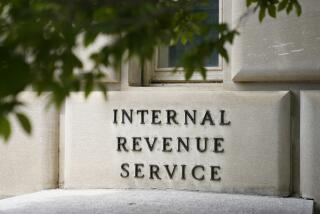Plan Wisely Before Selling and Give Yourself a Nice Tax Break
- Share via
Although a loss on the sale of your principal residence is never tax deductible, most sellers who plan ahead can avoid owing tax on their profitable home sale.
Since 1997, Internal Revenue Code 121 has simplified most principal residence sales. In fact, it’s no longer necessary to even report most exempt home sales less than $250,000 to the IRS.
To qualify, the seller or sellers must have owned and occupied their principal residence an “aggregate” two years during the last five years before its sale. The two years need not be continuous occupancy.
If a house or condominium is owned by a qualified resident, up to $250,000 of principal residence sale capital gains are tax-free. When a husband and wife, filing jointly, both qualify, then up to $500,000 of home-sale profits are tax-free. Title need only be in one spouse’s name if both meet the two-year occupancy test.
Once the aggregate two-year ownership and occupancy test is met, the residence need not be occupied by the owner or owners. For example, if you lived in your house for two years and then rented it to tenants for the last three years (or less) before selling it, you qualify for up to $250,000 of tax-free home sale profits (up to $500,000 for a qualified married couple filing jointly).
This tax break can be used as frequently as every 24 months. For example, you might buy a fixer-upper house, move in, renovate it while living in the home and make a profitable sale after as little as 24 months of ownership and occupancy. If you do this over and over every 24 months, you’ll soon become known as a “serial home seller.” How else can you earn up to $250,000 of tax-free profits every two years?
Most couples in the process of getting a divorce soon learn Internal Revenue Code 1041 allows tax-free inter-spousal realty title transfers during the marriage or as part of a divorce.
However, the old pre-1997 tax law was unfair, granting one ex-spouse possession of the family home until the youngest child turned 18 or 21, at which time the home was to be sold. Under the old tax law, the ex-spouse living in the house got all the tax breaks when selling, and the ex-spouse not living in the home got none.
But the 1997 Tax Act allows both spouses to claim up to $250,000 of tax-free profits, even if one spouse is not living in the residence. In other words, if an ex-spouse (called the “in spouse”) lives in the family home for at least two of the five years before its sale, then the nonresident “out spouse” can also qualify for up to $250,000 of home sale tax-free profits.
Internal Revenue Code 121 has a special rule for a surviving spouse. He or she can claim up to $500,000 of principal residence sale tax-free profits if the home is sold in the year of the other spouse’s death. But if the home is sold in the next tax year after the spouse’s death, then only up to $250,000 of home sale profits are tax-free.
This rule might seem harsh, forcing widows and widowers to quickly sell their homes or lose an extra $250,000 of tax-free profits. However, the surviving spouse’s adjusted cost basis on the half of the home received from the deceased spouse is usually “stepped up” to market value. In community property states, the surviving spouse’s new basis is usually stepped up to market value on the entire home’s value, so this is not an issue in those states.
When two or more unmarried co-owners each meet the ownership and occupancy tests, each co-owner can claim up to $250,000 of tax-free sale profits when the home is sold.
To illustrate, suppose two friends own and occupy their principal residence at least two out of the five years before its sale. The tax result is up to $500,000 total tax-free sale profits, up to $250,000 for each co-owner. If three friends own and occupy a principal residence two out of the five years before its sale, the result is up to $750,000 of tax-free sale profits.
If you own a second or vacation home, in the right circumstances, its sale might be tax-free if you meet the two-year ownership and occupancy test.
For example, Barbara and George spend November through April each year in their Houston home. They spend the other six months, from May through October, at their home in Kennebunkport, Maine.
If they should decide to sell either residence and can prove it was their principal home an “aggregate” two out of the last five years before sale, then it can qualify for up to $250,000 of tax-free profits per qualified seller.
If your home sale profits exceed the $250,000 or $500,000 limits, it is possible to shelter more than these amounts from capital gain taxation.
This is accomplished by converting the property into rental status. Then, regardless of the sale profit amount, the property can become eligible for an IRC 1031(a)(3) tax-deferred Starker delayed exchange for another investment or business property of equal or greater cost and equity. There is no minimum rental time before the converted previous personal residence becomes eligible for a tax-deferred exchange.
Home sellers who are knowledgeable about home sale tax avoidance are often surprised how simple IRC 121 really is. Careful tax planning can easily result in principal residence tax-free sales profits up to $250,000 (up to $500,000 for a married couple filing jointly). Consult with a tax advisor to maximize tax savings from a home sale.
*
Robert J. Bruss is a syndicated columnist as well as a real estate investor, lawyer, broker and educator in the Bay Area.
More to Read
Inside the business of entertainment
The Wide Shot brings you news, analysis and insights on everything from streaming wars to production — and what it all means for the future.
You may occasionally receive promotional content from the Los Angeles Times.










